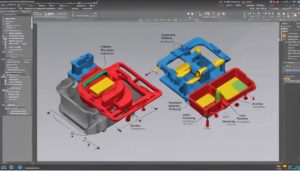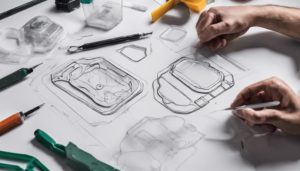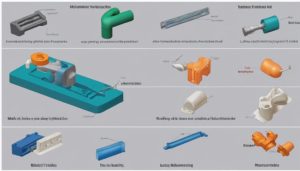Injection molding involves melting plastic pellets in a machine at high temperatures (150-350°C), then injecting the molten material into a mold under high pressure. The mold, designed to shape the final product, determines wall thickness and other features. Cooling follows to solidify the part, preventing defects. Ejector pins remove the solidified part from the mold for further processing. The process gives precise, complex components efficiently. Different materials like thermoplastics and silicone offer unique advantages. If you want to understand more about this versatile manufacturing method and its wide-ranging applications, explore the detailed steps outlined in the research.
Process Overview
In the domain of injection molding, the process overview serves as a fundamental framework delineating the intricate stages from material preparation to mold cavity injection. Injection molding involves the precise melting of thermoplastic materials, such as polypropylene or polycarbonate, at high temperatures. The molten thermoplastic is then injected into a mold cavity under controlled conditions. The injection phase requires careful monitoring of parameters like injection pressure, speed, and temperature to guarantee the material flows properly and fills the mold completely.
During the molding stage, the thermoplastic material solidifies within the mold, taking on its final shape. This process is reversible for thermoplastics, allowing for reprocessing and recycling. Unlike thermoplastics, thermoset materials undergo a chemical reaction during molding, resulting in irreversible hardening. Silicone injection molding, on the other hand, utilizes liquid silicone rubber for specialized applications that require flexibility and durability.
Injection molding is a versatile manufacturing process widely employed in industries such as aerospace, medical, automotive, and consumer goods due to its efficiency and precision.
Material Preparation

Raw plastic pellets undergo an essential transformation within the injection molding process as they are meticulously prepared for the subsequent stages of production.
- The plastic pellets are poured into the hopper of the injection molding machine, initiating the material preparation phase.
- Heating temperature plays a critical role in the process, typically ranging from 150 to 350 degrees Celsius to melt the plastic material effectively.
- The molten plastic is then pushed into the mold cavity by a hydraulic ram or rotating screw at high pressure, ensuring that the material fills the mold completely and accurately.
Material preparation is a fundamental step in injection molding, laying the foundation for the entire manufacturing process. It is imperative to achieve the right heating temperature and apply sufficient pressure to guarantee the quality and consistency of the final product. By carefully controlling these factors during material preparation, manufacturers can uphold stringent standards and produce high-quality plastic components efficiently.
Mold Injection

Utilizing high pressure, the injection molding process involves introducing molten plastic material into a meticulously designed mold cavity. The mold plays an essential role in shaping the final product, containing various features and details that will be replicated in the plastic part. The molten plastic material, typically in pellet form, is heated to a specific temperature and injected into the mold under high pressure. The high pressure guarantees that the mold cavity is completely filled, resulting in a precise and accurate reproduction of the mold's design.
The design of the mold is vital in determining the quality and characteristics of the final plastic part. It defines factors such as wall thickness, surface finish, and part dimensions. The ability to control these parameters precisely is what makes injection molding a highly versatile manufacturing process. Once the molten plastic is injected into the mold, it undergoes a cooling and solidification process before the ejection system removes the newly formed plastic part for further processing.
Cooling and Solidification

How does the controlled cooling process in injection molding impact the uniform solidification of plastic parts and prevent issues like warping and shrinkage? Proper cooling plays a critical role in ensuring the quality of injection molded parts. Here are three key points to keep in mind:
- Cooling Time: The cooling time in injection molding can vary from a few seconds to minutes, depending on factors such as part size and complexity. Properly managing the cooling time is essential for achieving uniform solidification and preventing defects.
- Proper Cooling: Maintaining the right cooling temperature is vital to avoid issues like warping or shrinkage in the final plastic parts. By controlling the cooling process, manufacturers can enhance the overall quality of the components.
- Cooling Channels: Cooling channels integrated into the mold design help regulate the temperature during the cooling process. These channels accelerate the solidification of the plastic material, contributing to consistent part quality and dimensional accuracy.
Part Ejection

Upon completion of the cooling and solidification process, the next vital step in injection molding is the efficient removal of the plastic component from the mold cavity, known as part ejection. Ejector pins or plates are essential components used in part ejection, exerting force to push the solidified parts out of the mold. This process guarantees that the molded parts are cleanly and swiftly ejected from the cavity.
The ejected parts are typically directed into a compartment or onto a conveyor belt for further processing or inspection. During part ejection, excess plastic removal is also carried out to eliminate any unwanted spurs or flash from the molded part. This step is essential in ensuring that the final product meets the required specifications and quality standards.
Additionally, finishing processes such as polishing or dying may be necessary post-ejection to enhance the appearance and functionality of the plastic component.
Quality Control Measures

Quality control measures in injection molding play a pivotal role in guaranteeing the precision and consistency of produced parts.
- First Article Inspection (FAI): Verifies part dimensions and features to make sure initial quality standards are met.
- Statistical Process Control (SPC): Monitors and controls the injection molding process for consistency and identifies any variations that may affect quality.
- Process Failure Mode and Effects Analysis (PFMEA): Helps in identifying potential failure modes and their effects on the quality of the parts.
These measures are essential for maintaining high-quality standards in injection molding processes. FAI ensures that the first parts produced meet the required specifications, SPC helps in continuous monitoring to prevent defects, and PFMEA aids in proactively addressing any potential quality issues. By integrating these quality control measures, manufacturers can uphold the desired precision, consistency, and overall quality of injection molded parts.
Key Parameters in Injection Molding

Key parameters in injection molding are critical factors that greatly influence the efficiency and quality of the manufacturing process. Mold temperature control plays an essential role in guaranteeing the quality of the final parts by influencing material flow and solidification.
Proper adjustment of clamping force is necessary to maintain the integrity of the mold structure during the injection process, preventing defects and ensuring consistent part dimensions.
Additionally, the recovery rate in injection molding directly impacts production efficiency and cycle times, making it a pivotal parameter to optimize for cost-effective manufacturing.
Injection pressure, typically ranging from 500 to 1500 bar, facilitates material flow into the mold cavity efficiently, while carefully adjusting the nozzle pressure ensures a consistent injection process.
Types of Injection Molding

Let's explore the various types of injection molding, focusing on common molding techniques, material choices impact, and the equipment used in the process.
Understanding these key points will provide insight into the diverse applications and advantages of different injection molding methods.
Common Molding Techniques
Within the domain of injection molding, various techniques are utilized to cater to distinct material properties and desired outcomes.
- Thermoplastic injection molding is reversible, allowing for recycling of materials.
- Thermoset injection molding uses materials that cannot be remelted, providing durability.
- Silicone injection molding utilizes liquid silicone rubber for flexible and precise parts.
Each technique offers unique advantages based on the material used and the final product requirements. Thermoplastic injection molding is favored for its recyclability, while thermoset injection molding provides robustness. Silicone injection molding stands out for its ability to create intricate and flexible components. These varied approaches showcase the adaptability of injection molding in meeting diverse industry needs and producing a wide array of products.
Material Choices Impact
Injection molding material choices greatly impact the outcome and performance of various products through distinct types of molding processes.
Thermoplastic injection molding, utilizing resin pellets, allows for material reusability and recycling as it can be melted and reshaped. Thermoset injection molding is ideal for parts needing high heat and chemical resistance, ensuring durability. Silicone injection molding, known for flexibility, is often used in products like medical devices due to its durability.
Common thermoplastic materials like ABS and Polypropylene are frequently employed in consumer goods and automotive components. In contrast, thermoset materials such as epoxy resins are preferred for parts requiring superior heat resistance, commonly found in electrical and automotive applications.
The choice of material greatly influences the final properties of the product as the material cools, impacting factors like chemical resistance and durability.
Equipment Used in Process
Injection molding processes rely on specialized equipment that includes hydraulic or electric machines with distinct components such as feed hoppers, heated barrels, injection screws, gates, and mold tools.
- Types of Injection Molding Machines: Different machines cater to specific molding processes such as thermoplastic injection molding, thermoset injection molding, and liquid silicone rubber injection molding.
- Thermoplastic Injection Molding: Ideal for consumer products and automotive components due to its recyclable nature.
- Liquid Silicone Rubber: Offers flexibility and durability, making it suitable for specialized applications like medical devices.
Applications and Benefits

The versatile process of injection molding finds extensive applications across diverse industries, offering efficient production of complex components with notable precision and consistency. Injection molding is widely utilized in industries such as aerospace, medical equipment, and automotive for manufacturing intricate parts with high production rates. It supports advanced techniques like overmolding and insert molding, enabling the creation of complex and multi-material components. This manufacturing method is particularly beneficial for mass production, providing cost-effective solutions for producing large quantities of parts with minimal waste. Additionally, injection molding is commonly employed in the manufacturing of consumer products, household items, and components for industries such as building and construction and the medical field due to its versatility and ability to deliver high-quality parts consistently.
| Applications | Benefits | Industries Benefiting | Precision and Consistency |
|---|---|---|---|
| Aerospace | Efficient Production | Aerospace | High-Quality Components |
| Medical Equipment | Complex Components | Medical Equipment | Consistent Output |
| Automotive | High Production Rates | Automotive | Precision Engineering |
Frequently Asked Questions
How Does Injection Molding Work Step by Step?
Injection molding works step by step through various stages:
- First, raw plastic pellets are fed into the machine's hopper.
- The plastic is melted in a heated barrel and injected into the mold cavity under pressure to ensure complete filling.
- Once the mold is filled, the plastic is cooled and solidified.
- Finally, the cooled plastic part is ejected from the mold for additional finishing processes.
This method allows for the production of high-quality plastic parts with precision and efficiency.
What Are the 4 Stages of Injection Molding?
The 4 stages of injection molding encompass feeding and melting the thermoplastic material. Injecting the molten plastic into the mold follows this step.
Allowing for holding and cooling time for proper solidification comes next.
How Does the Injection Molding Machine Work?
An injection molding machine operates by utilizing an injection ram or rotating screw plunger to push material into a mold at high pressure. This process, typically executed at pressures of 100-150 MPa, facilitates the creation of intricate products with high precision.
Molds employed in injection molding are commonly crafted from materials like copper, aluminum, or tool steels to withstand the demanding conditions.
The machine's production capacity can vary greatly, ranging from 12,000 to 2.2×10^6 mm^3 injection capacity.
How Does Plastic Start for Injection Molding?
To prepare plastic for injection molding, raw plastic pellets or granules are typically utilized. These materials serve as the initial form of the plastic before it undergoes the molding process.
The pellets are fed into the hopper of the injection molding machine where they are melted within the machine's heated barrel. This initial melting stage is vital for transforming the solid plastic into a molten state suitable for injection molding.
Conclusion
To sum up, injection molding is a precise process that involves material preparation, mold injection, cooling, part ejection, and quality control measures.
Key parameters play a vital role in achieving the best results, with various types of injection molding utilized for a wide range of applications.
The benefits of this method include efficiency, accuracy, and cost-effectiveness in producing intricate parts for diverse industries.
Essentially, injection molding is a pivotal process for producing high-quality components through meticulous manipulation.







